Moulding plasteline
has been a timeless pastime for children around the globe. This is a story of
one particular child who never gave it up, but instead turned it into something
truly magical.

Constantly fiddling with those colorful masses, Thomas Künstler started creating figures from a very early age and, led by his father, gave them life with a camera. After he discovered the world of stop-motion animation, things were set in motion... and he wasn't able to stop. Years passed and soon he left his home in Italy to study Film Production in England. Although he was working on different kinds of movies for his studies, the passion for stop-motion never faded and it turned into a continuous side-project. While studying, he got aquainted with several Greeks and, intrigued, he explored their culture. The more he knew about it, the more it left him captivated and inspired his works. The sound of traditional music and the dances, the melodies and instruments, especially the rebetiko (ρεμπέτικο) sparked his interest.
 With plots based on
everyday life, he carefully constructs scenes with his plasteline figures as
main actors surrounded by furniture from dollhouses and various objects and
materials. The hardest part is also the first one he has to do - devise a
story. One that would require little movement, no dialogue and a message still
clearly getting across. After that comes mixing the colours and building the
characters. Everything he does, he does on his own and while professionals use
bigger models, harder materials and wire armatures for their figures, he sticks
to his small-scale, apartment-friendly sizes and soft plasteline. Of course,
that means limbs fall off every now and then, dirt accumulates easily so
constant restoring is needed as he moves his characters through 25 frames for
every second of the movie. All taken into account, he still describes the whole
process of creating this kind of animation as very therapeutic. His works are
often infused with the element of love and with the eyes of a dreamer he talked
about his movies. Then I finally saw the finished works of art. Thomas presented
two of his animated films (which can also be viewed here: http://www.thomaskunstler.com/portfolio_page/den-les-kouventa, http://www.thomaskunstler.com/portfolio_page/rebetiko) titled „Den Les Kouventa“ and „Rebetiko“.
The way he presented a story with such little movement was stunning. The
simplified mute faces told tales of love, supported by skilled use of camera,
often dimmed light that shaped the atmosphere and
sounds that had to
represent all the noises and materials that weren't actually present. It was
apparent that he put his soul into creating these works. Greeks that were
introduced to them were honoured that a foreigner felt so close to their
culture and explored the potential of aspects they took for granted.
With plots based on
everyday life, he carefully constructs scenes with his plasteline figures as
main actors surrounded by furniture from dollhouses and various objects and
materials. The hardest part is also the first one he has to do - devise a
story. One that would require little movement, no dialogue and a message still
clearly getting across. After that comes mixing the colours and building the
characters. Everything he does, he does on his own and while professionals use
bigger models, harder materials and wire armatures for their figures, he sticks
to his small-scale, apartment-friendly sizes and soft plasteline. Of course,
that means limbs fall off every now and then, dirt accumulates easily so
constant restoring is needed as he moves his characters through 25 frames for
every second of the movie. All taken into account, he still describes the whole
process of creating this kind of animation as very therapeutic. His works are
often infused with the element of love and with the eyes of a dreamer he talked
about his movies. Then I finally saw the finished works of art. Thomas presented
two of his animated films (which can also be viewed here: http://www.thomaskunstler.com/portfolio_page/den-les-kouventa, http://www.thomaskunstler.com/portfolio_page/rebetiko) titled „Den Les Kouventa“ and „Rebetiko“.
The way he presented a story with such little movement was stunning. The
simplified mute faces told tales of love, supported by skilled use of camera,
often dimmed light that shaped the atmosphere and
sounds that had to
represent all the noises and materials that weren't actually present. It was
apparent that he put his soul into creating these works. Greeks that were
introduced to them were honoured that a foreigner felt so close to their
culture and explored the potential of aspects they took for granted.  Grateful for the
opportunity to meet such a talented young individual, I start thinking about how
many more of them, undiscovered, spend their hours ever so slightly moving fragile
figures frame by frame, hoping their stories will reach our hearts.
Grateful for the
opportunity to meet such a talented young individual, I start thinking about how
many more of them, undiscovered, spend their hours ever so slightly moving fragile
figures frame by frame, hoping their stories will reach our hearts.


No comments:
Post a Comment